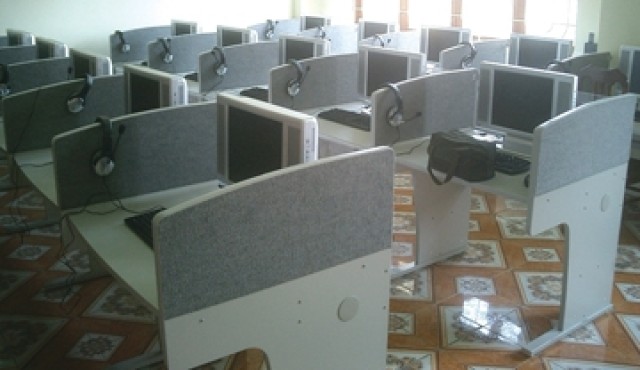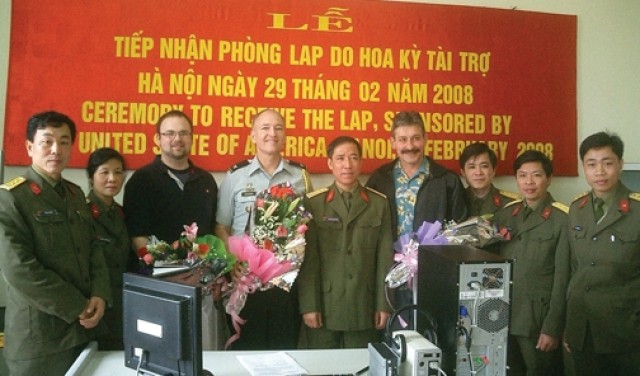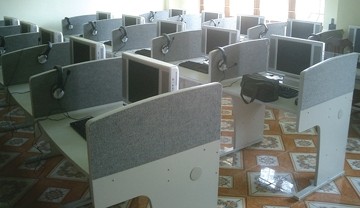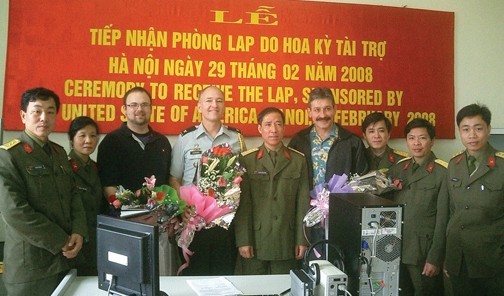TOBYHANNA ARMY DEPOT, Pa. - Employees from Tobyhanna have been helping foreign nationals learn and teach English by installing language labs in countries around the globe.
The International Military Education and Training (IMET) Language Laboratory is a classroom suite of computer and audio/visual equipment that is used to teach English to foreign military and government civilian members so they can study or train in the United States. Tobyhanna fabricates and installs the classrooms.
"We build the computers, integrate the systems, put together an electrical package and install them," said [Milford resident] Donna Phillips, project manager, C4ISR Maintenance Division, Production Engineering Directorate. Phillips oversees the engineering and administration of the project. "We have also recently expanded the mission to include formal training on maintenance of the systems and use of the software."
The IMET Language Laboratory Program Management is located at the U.S. Army CECOM-Life Cycle Management Command in Fort Monmouth, N.J. The program is managed through CECOM's Security Assistance Management Directorate (SAMD). It was overseen by John Allen since its inception in 2001, and that role was taken over by Michael Cerreto in 2008. Allen and Cerreto are employees in the SAMD.
CECOM is the provider of English language labs via Tobyhanna Army Depot. The program includes production, installation, sustainment and maintenance of various language laboratories. All of the labs come with appropriate furniture and can be purchased with a variable number of stations to accommodate different size classes. Depot employees built about 50 IMET language labs in fiscal year 2007.
The new labs meet or exceed all training requirements established by the Defense Language Institute-English Language Center (DLIELC) at Lackland Air Force Base, Texas. Also, language software can be purchased from the center. The Department of Defense agency is responsible for the management and operation of the Defense English Language Program.
According to Gabor Boda, chief C2/Aviation/Power Division, SAMD, CECOM, there are about 200 countries named on their official listing, and more than 150 of them are using language labs.
"I would say more than 80 percent of all countries have language labs," Boda said. "Our efforts include almost every nationality and native tongue you can imagine."
Each lab consists of up to 30 student carrels. A carrel is a small enclosure designed for privacy in studying and using the interactive materials. The instructor can use various equipment and formats, such as videocassette tape, compact disc, digital videodisc or audiocassette tape, to interface with the students.
Lab installations are typically performed by a three-person depot team. Since production of the initial language lab, teams have traveled to Africa, Southwest Asia, Central and South America, which includes countries such as Tunisia, Thailand, Slovakia and Chile. Labs have also been set-up in countries in Asia, such as Vietnam and Turkey. Plans are underway to install a lab in Vietnam in the near future. The cost of the installation varies depending on the lab configuration and the destination.
Even though the depot sends out site survey teams, Phillips explained that they never know what to expect when they arrive on scene to install the lab.
"I have to give the teams a lot of credit," Phillips said. "They walk into an empty room and have to fit the equipment ordered into the space provided."
This according to her is not always as simple as it sounds. She said the depot provides information hoping the country has everything ready for installation, but "sometimes the crews have to wing it."
The analog/digital labs allow the instructor to monitor students' computer work on the instructor console screen using the keyboard and mouse control. It can also send the instructor's screen to all or a designated group of students, and model a student's screen to all or a designated group. The student's computers can be controlled from the instructor's console.
There are three language lab configurations - analog, digital and resource center.
The multimedia language laboratory is a digital multimedia language laboratory which contains application software programmed specifically for language learning in a structured classroom environment.
The audio active language laboratory is an analog language laboratory that allows a student to hear a program via a headphone and to respond using the microphone.
The language learning resource center is configured as a local area network, which may be used as a single user PC lab allowing for group or independent learning.
"Working on the systems has been challenging," Phillips said. "There's a lot to coordinate, such as systems design, assembly, transportation and travel requirements."
Tobyhanna Army Depot is the Defense Department's largest center for the repair, overhaul and fabrication of a wide variety of electronics systems and components, from tactical field radios to the ground terminals for the defense satellite communications network. Tobyhanna's missions support all branches of the Armed Forces.
About 5,500 personnel are employed at Tobyhanna, which is located in the Pocono Mountains of northeastern Pennsylvania.
Tobyhanna Army Depot is part of the U.S. Army Communications-Electronics Life Cycle Management Command. Headquartered at Fort Monmouth, N.J., the command's mission is to research, develop, acquire, field and sustain communications, command, control, computer, intelligence, electronic warfare and sensors capabilities for the Armed Forces.




Social Sharing